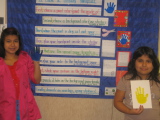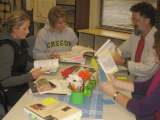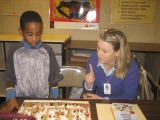-
Category 2
Selected in 2012
-
Grades: k - 5
School Setting: suburban
Town Population: 90,000
Student Enrollment: 420
Student Demographics:
Black/African American: 4%
Teacher/Student Ratio: 1:29
White/Caucasian: 39%
Hispanic: 46%
Hawaiian/Pacific Islander: 0%
Asian: 4%
Native American: 2%
Other: 5%
% Reduced Lunch: 74%
% ELL Learners: 35%
Founded: 1980 -
PRINCIPAL:
Bob Matuszak -
CONTACT:
9150 SW Downing Drive
Beaverton, OR 97008
503-524-1300
robert_matuszak@beaverton.k12.or.us
Greenway Elementary
Beaverton, OR
Much of our professional development comes from teachers learning, analyzing and presenting best practices to the staff. Some of the resources teacher leaders have used include; "Teach Like a Champion", by Doug Lemov, "Making Content Comprehensible for Elementary English Learners, The SIOP Model" by Jana Echevarria, MaryEllen Vogt, and Deborah J. Short, "What Really Matters for Struggling Readers", by Richard Allington, The "Daily 5" and "The Café Book" by Gail Boushey.
- What is the single most important factor in the success of your school that others could replicate?
- Though it is difficult to single out just one factor that accounts for our success, the changes we have made over the past two years in our reading interventions have accounted for positive growth in student achievement. Prior to two years ago, we had a "Walk to Read" model of providing interventions. As we tracked student data, we noticed that once a child fell behind in reading, the gap in achievement continued to grow despite our small group intervention model. Utilizing suggestions in Richard Allington’s book, "What Really Matters for Struggling Readers", we restructured our reading interventions from a Walk to Read, small group model to one where students meet for shorter periods but were provided 1:1 or 1:2 support. Students are pulled for 10 or 15 minute blocks and then return to class. Intensive students in kindergarten and first grade are pulled twice a day. Both classroom teachers and instructional assistants use leveled books and "Café" lessons to teach strategies in fluency, comprehension, accuracy and expanded vocabulary. Students are progress monitored regularly. Teachers meet weekly to discuss student achievement and make instructional decisions. Of course, there are many other factors that also help to positively impact student growth. Our caring staff makes an effort to break down barriers with families for whom English is a second language. Our teachers spend time in thoughtful collaboration concerning instructional practices. They teach using SIOP strategies and work to provide shared experiences for their students. It is the hard work and dedication of our staff that truly has the greatest impact on our students!
- Describe the program or initiative that has had the greatest positive effect on student achievement.
-
It is the continued attention to student progress and differentiated instructional practices that have made the greatest impact on student achievement.
Teachers are strategic in using learning targets based on the State Standards to plan instruction. After writing the targets in student friendly language, they are posted and reviewed at the onset of lessons. For students, the targets help to outline a purpose for learning and pinpoint a desired outcome. The targets help to guide instruction and keep lessons focused.
Teachers meet with individual or small groups of students to discuss specific goals and teach strategies. Time is set aside weekly for teacher collaboration to discuss teaching practices, look at student data and share resources. Additional interventions are provided in very small groups (1:1 or 1:2) using instructional assistants. Additional support is offered in after school programs for reading, math, and homework assistance. Using data to inform instructional decisions, tailoring lessons to specific needs of the students and providing interventions has helped our students make progress. - Explain how Title I funds have supported your improvement efforts.
- Our Title I funds are primarily used to provide additional adult support to our students who struggle in reading. Title I assistants under the guidance of our intervention specialist provide 1:1 or 1:2 support to our students. This approach helps support our goal that “all” students will be at grade level in reading by the end of first grade. In addition to this mentoring model, our Title I funds provide after school support to students who struggle in reading or math. Since time is a commodity, this model extends our instructional day and lessens the negative impact on students when they are pulled out of their classroom during whole group instruction. For the past two years, we used a portion of our Title I funds to buy books for students so they had reading material over the summer. Students self-select their books with guidance from a staff member with the goal of selecting books that are “Just Right”. The data was clear that students who did not read over the summer started school in the fall behind where they were the previous spring. The goal of our summer reading program is to reduce the “summer slide”. Finally, we open our library once a week during the summer months so students can listen to a story and check out books.
- Identify the professional development activities you use to improve the teaching portion of the teaching and learning process.
- Much of our professional development comes from teachers learning, analyzing and presenting best practices to the staff. Some of the resources teacher leaders have used include; "Teach Like a Champion", by Doug Lemov, "Making Content Comprehensible for Elementary English Learners, The SIOP Model" by Jana Echevarria, MaryEllen Vogt, and Deborah J. Short, "What Really Matters for Struggling Readers", by Richard Allington, The "Daily 5" and "The Café Book" by Gail Boushey and Joan Moser, Reggie Routman’s "Urgency and School Change Conference" in Seattle, Washington, and video tutorials by Anita Archer on student engagement. However the effectiveness of our staff development is largely due to the willingness of our staff to learn and grow. Our commitment to collaboration and sharing best practices continues to be the single most important factor in our learning.
- Describe how data is used to improve student achievement and inform decision making.
- For the past six years, Greenway has utilized an intentional approach in using data to inform instruction. In reading, we use DIBELS and DRA to regularly assess students. Students who are identified as intensive (according to DIBELS) are progress monitored at least once every two weeks. Strategic students (according to DIBELS) are progress monitored every three to four weeks. We use EasyCBM Math assessment to provide benchmark and progress monitoring in math. In writing, we provide regular, on-demand work samples which are cross-scored to ensure accurate results. In addition to our weekly PLC time with grade-level teams, our data teams meet every six weeks to review student data and make recommendations for intervention changes to meet the needs of each student. This systematic approach to using data to inform instruction ensures our students won’t fall between the cracks.
Stats
-
Category 2
Selected in 2012
-
Grades: k - 5
School Setting: suburban
Town Population: 90,000
Student Enrollment: 420
Student Demographics:
Black/African American: 4%
Teacher/Student Ratio: 1:29
White/Caucasian: 39%
Hispanic: 46%
Hawaiian/Pacific Islander: 0%
Asian: 4%
Native American: 2%
Other: 5%
% Reduced Lunch: 74%
% ELL Learners: 35%
Founded: 1980 -
PRINCIPAL:
Bob Matuszak -
CONTACT:
9150 SW Downing Drive
Beaverton, OR 97008
503-524-1300
robert_matuszak@beaverton.k12.or.us







